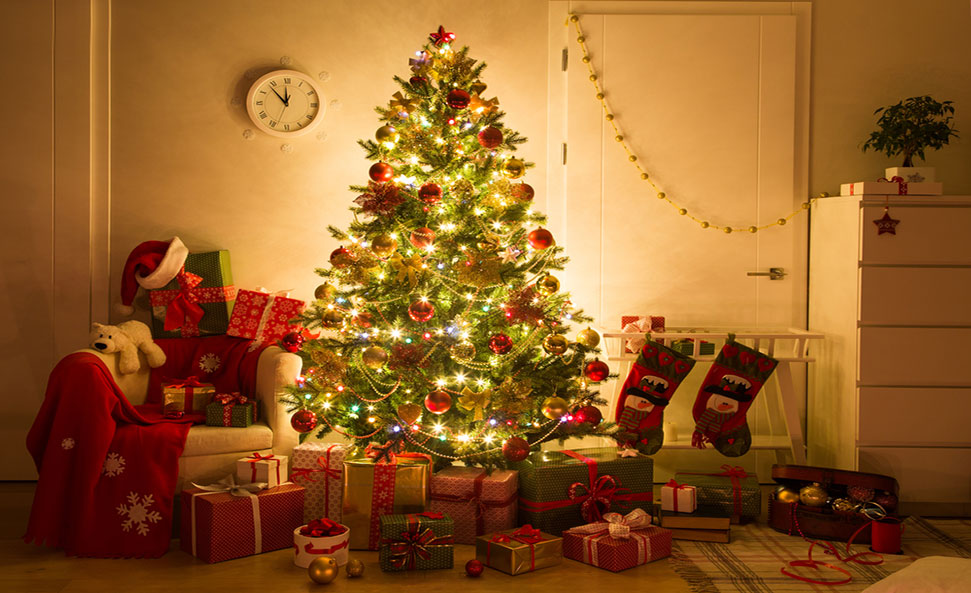Evergreen trees (and other evergreen plants) have traditionally been used to celebrate winter festivals (pagan and Christian) for thousands of years.
Pagans used branches of evergreen trees to decorate their homes during the winter solstice, as it made them think of the spring to come.
The Romans used Fir Trees to decorate their temples at the festival of Saturnalia. However, they were quite different to what we think of as Christmas Trees now.
Nobody is really sure when Fir trees were first used as Christmas trees. It probably began about 1000 years ago in Northern Europe.
Christmas Trees might well have started out as ‘Paradise Trees’ (branches or wooden frames decorated with apples). These were used in medieval German Mystery or Miracle Plays that were acted out in front of Churches during Advent and on Christmas Eve. In early church calendars of saints, 24th December was Adam and Eve’s day. The Paradise Tree represented the Garden of Eden. It was often paraded around the town before the play started, as a way of advertising the play. The plays told Bible stories to people who could not read.
Christmas Trees as they came to be now started around the late 1400s into the 1500s. In what’s now Germany (was the Holy Roman Empire then), the Paradise Tree had more decorations on it (sometimes communion wafers, cherries and later pastry decorations of stars, bells, angels, etc. were added) and it even got a new nickname the ‘Christbaum’ or ‘Christ Tree’.

Some early Christmas Trees, across many parts of northern Europe, were cherry or hawthorn plants (or a branch of the plant) that were put into pots and brought inside so they would hopefully flower at Christmas time. If you couldn’t afford a real plant, people made pyramids of woods and they were decorated to look like a tree with paper, apples and candles. It’s possible that the wooden pyramid trees were meant to be like Paradise Trees. Sometimes they were carried around from house to house, rather than being displayed in a home.
Some trees (or at least small tops of them or branches of fir trees) were hung from the ceiling, mainly in some parts of Germany, some Slavic countries and parts of Poland. This might have been to save space or they just looked nice hanging from the rafters! (If you have lighting hooks on the ceiling, they would also be an obvious place to hang things from.)
The first documented use of a tree at Christmas and New Year celebrations is argued between the cities of Tallinn in Estonia and Riga in Latvia! Both claim that they had the first trees; Tallinn in 1441 and Riga in 1510. Both trees were put up by the ‘Brotherhood of Blackheads’ which was an association of local unmarried merchants, ship owners, and foreigners in Livonia (what is now Estonia and Latvia).
Little is known about either tree apart from that they were put in the town square, were danced around by the Brotherhood of Blackheads and were then set on fire. This is like the custom of the Yule Log. The word used for the ‘tree’ could also mean a mast or pole, tree might have been like a ‘Paradise Tree’ or a tree-shaped wooden candelabra rather than a ‘real’ tree.
In the town square of Riga, the capital of Latvia, there is a plaque which is engraved with “The First New Year’s Tree in Riga in 1510”, in eight languages. You can find out more about the Riga Tree from this website: www.firstchristmastree.com
A picture from Germany in 1521 which shows a tree being paraded through the streets with a man riding a horse behind it. The man is dressed a bishop, possibly representing St. Nicholas.
In 1584, the historian Balthasar Russow wrote about a tradition, in Riga, of a decorated fir tree in the market square where the young men “went with a flock of maidens and women, first sang and danced there and then set the tree aflame”. There’s a record of a small tree in Breman, Germany from 1570. It is described as a tree decorated with “apples, nuts, dates, pretzels and paper flowers”. It was displayed in a ‘guild-house’ (the meeting place for a society of business men in the city).

The first person to bring a Christmas Tree into a house, in the way we know it today, may have been the 16th century German preacher Martin Luther. A story is told that, one night before Christmas, he was walking through the forest and looked up to see the stars shining through the tree branches. It was so beautiful, that he went home and told his children that it reminded him of Jesus, who left the stars of heaven to come to earth at Christmas. So he brought a tree into his house and decorated it with candles to represent the stars.
Some people say this is the same tree as the ‘Riga’ tree, but it isn’t! The story about Martin Luther seems to date to about 1536 and Riga tree originally took place a couple of decades earlier.
The custom of having Christmas trees could well have travelled along the Baltic sea, from Latvia to Germany. In the 1400s and 1500s, the countries which are now Germany and Latvia were them part of two larger empires which were neighbors.
Another story says that St. Boniface of Crediton (a village in Devon, UK) left England in the 8th centuryand traveled to Germany to preach to the pagan German tribes and convert them to Christianity. He is said to have come across a group of pagans about to sacrifice a young boy while worshipping an oak tree in honour of Thor. In anger, and to stop the sacrifice, St. Boniface cut down the oak tree and, to his amazement, a young fir tree sprang up from the roots of the oak tree. St. Boniface took this as a sign of the Christian faith and his followers decorated the tree with candles so that St. Boniface could preach to the pagans at night. St Boniface was certainly involved in spreading Christianity in parts of Germany, although the legends of the tree seems to have started several centuries later and they’re not mentioned in the early writings about St Boniface.
Haing Trees upside down has also been connected with St. Boniface. One story/theory says that he used the ‘triangle’ shape of an upside down fir tree to help explain the trinity in the Christian faith (God the Father, Jesus and the Holy Spirit). Being upside down it that looked a bit like a cross and so also helped to explain the crucifixion.
There is another legend, from Germany, about how the Christmas Tree came into being, it goes:
Once on a cold Christmas Eve night, a forester and his family were in their cottage gathered round the fire to keep warm. Suddenly there was a knock on the door. When the forester opened the door, he found a poor little boy standing on the door step, lost and alone. The forester welcomed him into his house and the family fed and washed him and put him to bed in the youngest sons own bed (he had to share with his brother that night!). The next morning, Christmas Morning, the family were woken up by a choir of angels, and the poor little boy had turned into Jesus, the Christ Child. The Christ Child went into the front garden of the cottage and broke a branch off a Fir tree and gave it to the family as a present to say thank you for looking after him. So ever since them, people have remembered that night by bringing a Christmas Tree into their homes!
In Germany, the first Christmas Trees were decorated with edible things, such as gingerbread and gold covered apples. In 1605 an unknown German wrote: “At Christmas they set up fir trees in the parlours of Strasbourg and hang thereon roses cut out of many-colored paper, apples, wafers, gold foil, sweets, etc.”.
Some other trees were used in different parts of Germany, such as box or Yew. In the duchy of Mecklenburg-Strelitz it was common to decorate just a branch of a yew tree.

At first, a figure of the Baby Jesus was put on the top of the tree. Over time it changed into a star like the Wise Men saw or an angel/fairy that told the shepherds about Jesus. The ‘angel’ might also might have started as a version of the ‘Christkind’ which translates as ‘The Christ Child’ but is normally shown as a little angel figure with blond hair!
The first Christmas Tree in the UK was probably set-up by Queen Charlotte, the German wife of King George III. Queen Charlotte grew up in Mecklenburg-Strelitz and in the 1790s there are records of her having a yew branch in Kew Palace or Windsor Castle. She helped to decorate it herself and it became a popular event for the royal court. In 1800 she had a full yew tree set-up at the Queen’s Lodge in Windsor for a children’s party for rich and noble families. Dr John Watkins, who went to the party described the tree like this: “…from the branches of which hung
bunches of sweetmeats, almonds and raisins in papers, fruits and toys, most tastefully arranged; the whole illuminated by small wax candles.”. And “…after the company had walked round and admired the tree, each child obtained a portion of the sweets it bore, together with a toy, and then all returned home quite delighted.”.
Soon having a tree had become popular amongst some rich families. Queen Charlotte died in 1818 and by then, having a Christmas Tree was a tradition among much of the upper classes.
There’s no mention of a Christmas Tree in ‘A Christmas Carol’ by Charles Dickens, which was published in 1843.
They became very popular throughout the country from the mid 1840s, when reports of ‘the Royal tree’ were printed in newspapers. In 1848, a drawing of “The Queen’s Christmas tree at Windsor Castle” was published in the Illustrated London News. It showed Queen Victoria, her German Husband Prince Albert and their young children around a tree which was set-up on a table. The drawing was republished in Godey’s Lady’s Book, Philadelphia in December 1850 (but they removed the Queen’s crown and Prince Albert’s moustache to make it look ‘American’!).
The publication of the drawing helped Christmas Trees become popular in the UK and USA.
In Victorian times, the tree would have been decorated with candles to represent stars. In many parts of Europe, candles are still used to decorate Christmas trees.
Christmas Tree ‘skirts’ started as Christmas Tree ‘carpets’. They were made from heavy fabric, often decorated and with fancy frills around the edges, and were used either on the floor, or on tables, and went under the trees and their stands – rather than ‘around’ them. They were used to catch the needles from the trees and also protect the floor or table tops from dripping wax coming from the candles on the trees.
In Germany in the early/mid 1800s it was also ‘fashionable’ to have a forest scene and/or a nativity scene under trees (especially if the trees were placed on tables) and so these scenes also stood on the Tree carpets.
At this point trees were either normally put in pots (if they still had roots on them) or they were attached to a larger piece of wood or other heavy support (if they’d been cut) and so the scenes help to hide these.
In the 1860s proper metal tree holders, for cut trees, started being made. If you were rich, you could get them in very fancy shapes – and some even had music boxes in them, so they ‘plinked’ Christmas tunes!
Less expensive tree holders also became available and were made out of cheaper metals (and they also didn’t look so good), so the ‘carpets’ became smaller and were also put ‘around’ the tree holders and became the Christmas tree skirts that we have today.
Lead and glass decorations started being made in the 1860s and 1870s. Some of the first glass decorations were apples – and that’s probably where round, red, baubles on Christmas Trees comes from! Frank Woolworth started selling glass ornaments in his stores in the USA in 1880.
We Will Love You To Join Our Over 180k Members Instagram Family With Just One Click @gharticles
Source: GhArticles.com
 GhArticles.com Every News in Detail
GhArticles.com Every News in Detail



